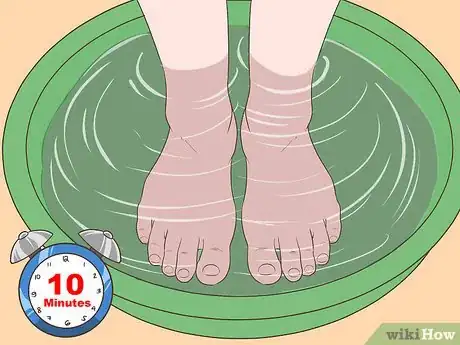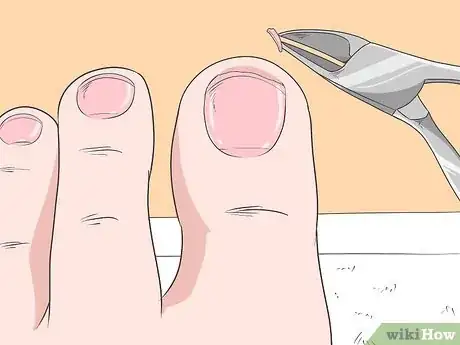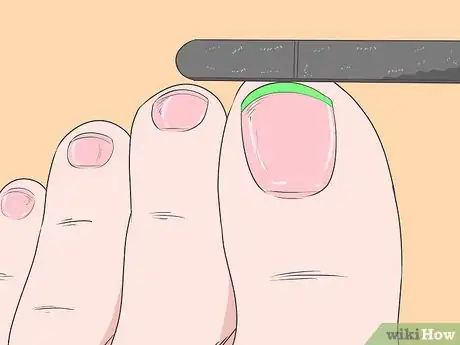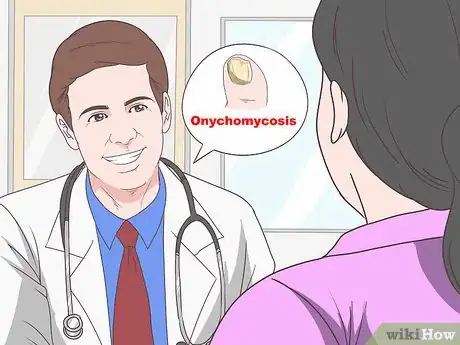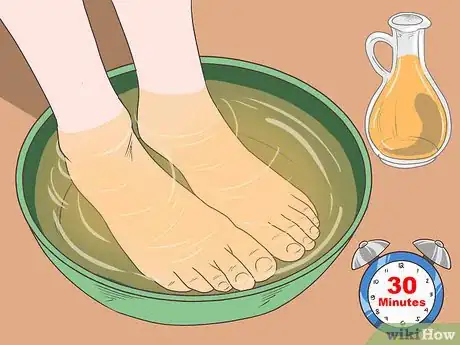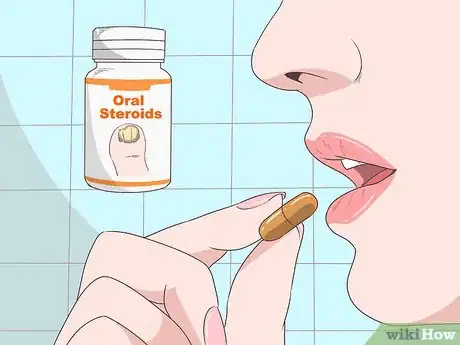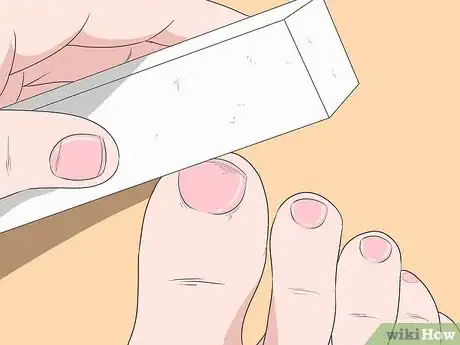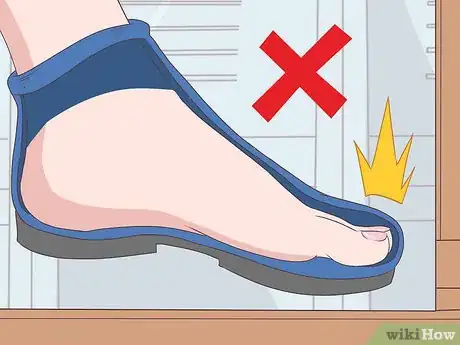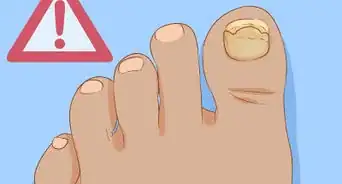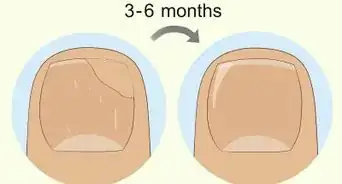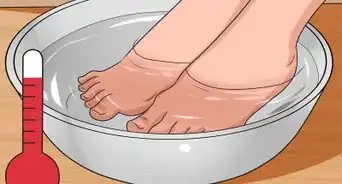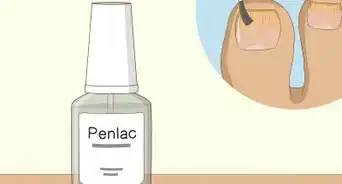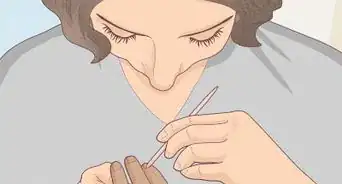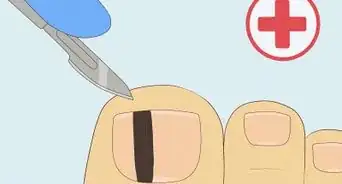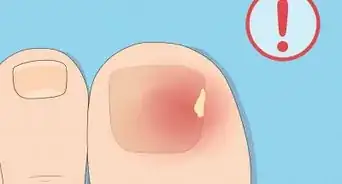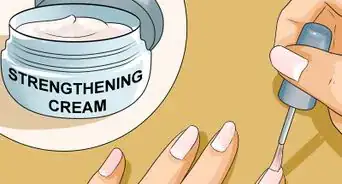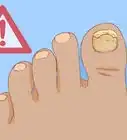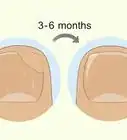This article was co-authored by Miguel Cunha, DPM and by wikiHow staff writer, Amy Bobinger. Dr. Miguel Cunha is the founder of Gotham Footcare and is a podiatrist based in Manhattan, New York. Dr. Cunha is a foot and ankle surgeon with experience treating a wide array of foot and ankle conditions from minor problems to complex reconstructive foot and ankle surgery. Dr. Cunha received his DPM from the Temple University School of Podiatric Medicine and completed his residency as the Chief Resident at the Washington Hospital Center and Georgetown University where he specialized in lower extremity trauma, diabetic limb salvage, and reconstructive surgery of the foot and ankle. Dr. Cunha is a member of the American Podiatric Medical Association, the New York Podiatric Medical Association, the American College of Foot and Ankle Surgeons, and is board certified in Podiatric Medicine.
There are 9 references cited in this article, which can be found at the bottom of the page.
This article has been viewed 278,285 times.
If you have thick toenails, you might feel embarrassed about showing your feet. Thick toenails are most commonly caused by fungus, but they can also be the result of aging, injury, or an underlying condition like diabetes or psoriasis. Luckily, many causes of thick toenails can be treated.
Steps
Trimming Thick Nails Safely
-
1Soak your feet for 10 minutes in warm water then dry thoroughly. Before you attempt to cut your thick toenails, you should soften them by soaking them in warm water for at least 10 minutes. When you’re finished, dry your feet completely, including between your toes.[1]
-
2Trim your toenails using nail nippers. Nail clippers are what we typically associate with trimming nails, but these are usually not strong enough to cut through thick toenails. Use nail nippers instead. Nail nippers have a handle that is longer and easier to grip than regular nail clippers, and they are designed to cut toenails straight across.[2]Advertisement
-
3Use small cuts and go straight across the nail. Small cuts help avoid splintering, which can be a problem with thick nails. As you’re trimming, cut straight across your nail. Don’t round the corners, as this can increase your risk for ingrown toenails.[3]
-
4Take care not to cut yourself, especially if you have poor circulation. Conditions like diabetes which cause thickened toenails may also cause you to have poor circulation. This can result in reduced sensation in your feet, meaning you might not notice right away if you cut yourself. Untreated cuts can lead to infections and serious health complications, so be sure to pay close attention while you’re trimming your toenails.[4]
-
5Gently file the edges of your toenails with an emery board or nail file. After you’ve trimmed your toenails, carefully use an emery board or nail file to smooth any sharp edges which might get caught on your socks.[5]
Treating Thick Toenails
-
1Visit your doctor to determine the cause.[6] The cause of thick toenails can be difficult to determine just by looking at your feet. If you notice your nails becoming thick or changing color, visit your doctor. Your doctor will likely ask you questions about your lifestyle and other health problems you may have, and may take a sample to send to a lab for testing to see if you have a fungal infection.[7]
- Thick toenails are most commonly caused by a fungal infection known as onychomycosis.[8]
- Thickening of the nail can also be caused by repeated injury to the toenail. This is often seen in athletes, but it can also be the result of wearing improperly-fitting shoes.
- Other causes of thick toenails include aging and underlying conditions like psoriasis and diabetes.[9]
-
2Use a prescription antifungal if the cause is a fungal infection.[10] If you are suffering from onychomycosis, your doctor will prescribe you an antifungal treatment. These can come in the form of a cream or ointment or an oral medication. Your doctor might also recommend a laser treatment to destroy the fungus.[11]
- Treating severe cases of fungal infection may require the removal of the nail in order to fully treat the nail bed below.
-
3Soak your feet in vinegar for an at-home fix for fungus. The pH level of vinegar is thought to destroy nail fungus. Fill a large bowl with an even mixture of hot water and plain vinegar. Soak your feet for up to 30 minutes at a time.
-
4Treat psoriasis flares with steroids. If you suffer from psoriasis, a flare may affect your toenails, causing them to thicken. If you’re suffering from a flare, your doctor can prescribe steroids, which help reduce the inflammation associated with psoriasis. You may be given oral steroids, although topical creams containing steroids are used more commonly.[12]
-
5Buff your toenails if the cause of thickening is due to age. Our toenails become thicker as we get older. Although this is a natural part of aging, you can help reduce the thickness by buffing your toenails with an emery board. If you prefer, you can have this done at a nail salon that offers pedicures.[13]
-
6Avoid impact or squeezing if your toenails have thickened after an injury. If injury is causing your toenails to become thicker, make sure you keep your toenails cut short, wear properly-fitting shoes, and try to avoid anything coming directly into contact with your toenail. If you’re an athlete, such as an ice skater, soccer player, or dancer, your feet go through a lot of high-impact moves on a regular basis. Protect your toenails by avoiding any kicks or moves that put direct pressure on them.[14]
- Thick toenails can also be caused by wearing shoes that are too tight. Wear shoes that fit properly, especially when engaging in strenuous activities.
Keeping Your Toenails from Becoming Thick
-
1Dry your feet thoroughly after showering or swimming. Make sure you completely dry your feet after you swim or shower to ensure your feet stay healthy. If your feet are damp, they will be more susceptible to a fungal infection.[15]
-
2Wear shoes that fit well and let your feet breathe. Since tight shoes can cause your toenails to thicken over time, be sure that your shoes fit well and don’t crowd your toes. In addition, choose shoes which allow your feet to breathe. This will help prevent fungus from growing.[16]
-
3Wear clean socks every day. Clean, fresh socks will help keep your feet dry, so put on a fresh pair every day. If you sweat a lot or if you get your feet wet you may need to change your socks more often.[17]
-
4
Expert Q&A
Did you know you can get expert answers for this article?
Unlock expert answers by supporting wikiHow
-
QuestionCan you get toenail fungus from your shoes?
 Miguel Cunha, DPMDr. Miguel Cunha is the founder of Gotham Footcare and is a podiatrist based in Manhattan, New York. Dr. Cunha is a foot and ankle surgeon with experience treating a wide array of foot and ankle conditions from minor problems to complex reconstructive foot and ankle surgery. Dr. Cunha received his DPM from the Temple University School of Podiatric Medicine and completed his residency as the Chief Resident at the Washington Hospital Center and Georgetown University where he specialized in lower extremity trauma, diabetic limb salvage, and reconstructive surgery of the foot and ankle. Dr. Cunha is a member of the American Podiatric Medical Association, the New York Podiatric Medical Association, the American College of Foot and Ankle Surgeons, and is board certified in Podiatric Medicine.
Miguel Cunha, DPMDr. Miguel Cunha is the founder of Gotham Footcare and is a podiatrist based in Manhattan, New York. Dr. Cunha is a foot and ankle surgeon with experience treating a wide array of foot and ankle conditions from minor problems to complex reconstructive foot and ankle surgery. Dr. Cunha received his DPM from the Temple University School of Podiatric Medicine and completed his residency as the Chief Resident at the Washington Hospital Center and Georgetown University where he specialized in lower extremity trauma, diabetic limb salvage, and reconstructive surgery of the foot and ankle. Dr. Cunha is a member of the American Podiatric Medical Association, the New York Podiatric Medical Association, the American College of Foot and Ankle Surgeons, and is board certified in Podiatric Medicine.
Board Certified Podiatrist If you're not maintaining proper hygiene of the shoe, they can contain both bacteria and fungus. I recommend that people spray Lysol inside and outside of their shoes, as that helps kill bacteria and fungus. Also, examine the wear and tear of your shoes and determine whether it's time to get rid of them.
If you're not maintaining proper hygiene of the shoe, they can contain both bacteria and fungus. I recommend that people spray Lysol inside and outside of their shoes, as that helps kill bacteria and fungus. Also, examine the wear and tear of your shoes and determine whether it's time to get rid of them.
References
- ↑ https://www.mayoclinic.org/healthy-lifestyle/adult-health/multimedia/nails/sls-20076741?s=2
- ↑ https://www.mayoclinic.org/healthy-lifestyle/adult-health/multimedia/nails/sls-20076741?s=2
- ↑ https://www.mayoclinic.org/healthy-lifestyle/adult-health/multimedia/nails/sls-20076741?s=2
- ↑ https://www.mayoclinic.org/healthy-lifestyle/adult-health/multimedia/nails/sls-20076741?s=2
- ↑ https://www.mayoclinic.org/healthy-lifestyle/adult-health/multimedia/nails/sls-20076741?s=2
- ↑ Miguel Cunha, DPM. Board Certified Podiatrist. Expert Interview. 22 April 2020.
- ↑ https://www.webmd.com/skin-problems-and-treatments/nail-problems#1
- ↑ Miguel Cunha, DPM. Board Certified Podiatrist. Expert Interview. 22 April 2020.
- ↑ https://www.webmd.com/skin-problems-and-treatments/psoriasis/nail-psoriasis
- ↑ Miguel Cunha, DPM. Board Certified Podiatrist. Expert Interview. 22 April 2020.
- ↑ https://www.webmd.com/skin-problems-and-treatments/nail-problems#1
- ↑ https://www.psoriasis.org/about-psoriasis/treatments/topicals/steroids
- ↑ http://www.nytimes.com/2012/10/02/science/why-do-toenails-thicken-as-we-age.html
- ↑ http://www.nytimes.com/2013/05/21/science/how-do-you-prevent-toenails-from-thickening-and-getting-deformed.html
- ↑ https://www.ncbi.nlm.nih.gov/pubmedhealth/PMH0072731/
- ↑ https://www.ncbi.nlm.nih.gov/pubmedhealth/PMH0072731/
- ↑ https://www.health.harvard.edu/skin-and-hair/toenail-problems
- ↑ Miguel Cunha, DPM. Board Certified Podiatrist. Expert Interview. 22 April 2020.
- ↑ https://www.ncbi.nlm.nih.gov/pubmedhealth/PMH0072731/
About This Article
Treatment for thick toenails depends on what's causing them. If you have a fungal infection, your doctor may prescribe an over-the-counter cream, oral medication, or laser therapy. If you are having a psoriasis flare, your doctor might prescribe topical steroids or injections. If your thick toenails are the result of injury caused by tight shoes, you should make sure you always wear comfortable shoes that don’t restrict your feet. Keep reading to learn how to trim thick toenails safely at home.
